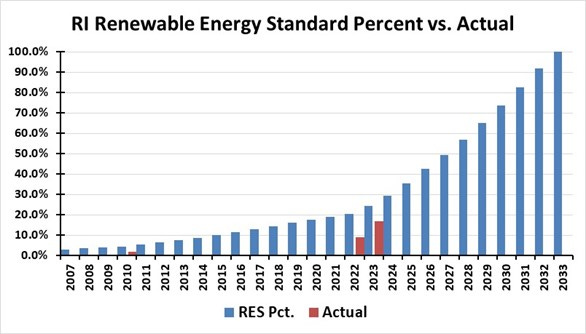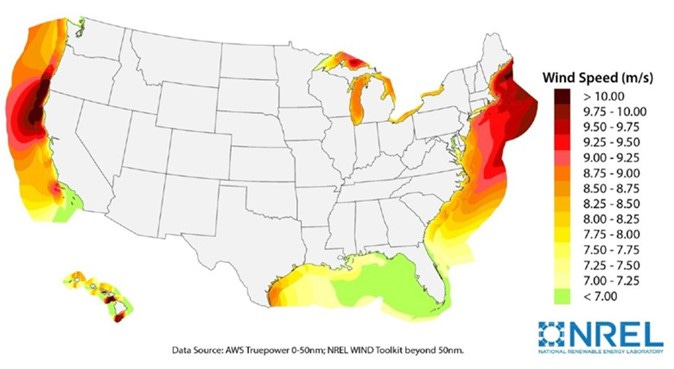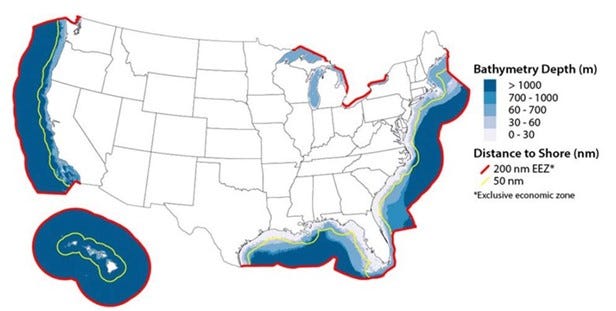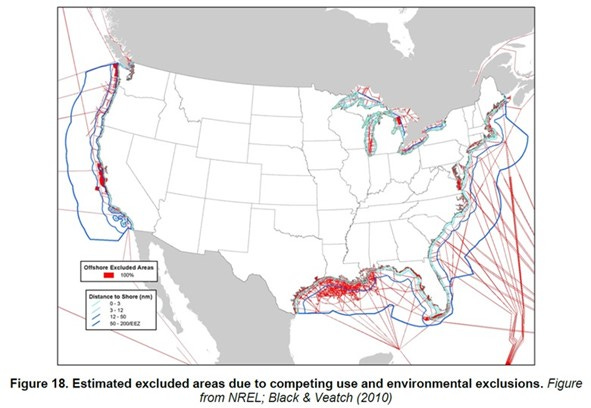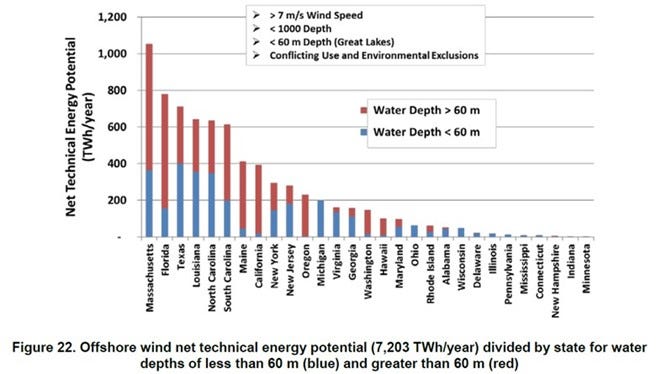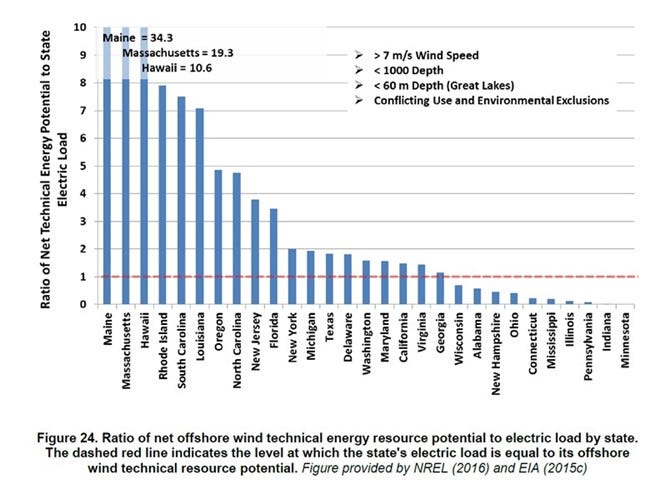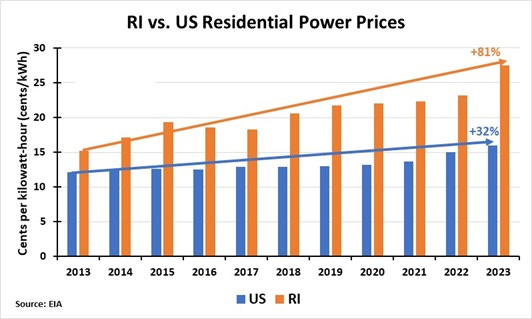Energy Musings - May 18, 2024
This is a long read. It is a white paper to help educate people in Rhode Island (our summer home) and elsewhere about the positives and negatives of offshore wind. It backs up an Op Ed.
Hold On To Your Wallet, Here Comes Offshore Wind
Summary
Rhode Island’s electricity is expensive. Residents likely have no idea how expensive it is nor why. Prices have been driven up by the state’s green energy policies. As the state rewards developers in the push for more solar and wind power, customers are footing the ever-growing bills. Major price increases will arrive with the power from offshore wind farms in New England waters currently being constructed and contracted.
New England coastal states are blessed with substantial offshore wind resources. The wind is free, we are told. The reality is it is among the most expensive electricity available and will drive up electric bills. Moreover, the explosive growth in offshore wind is already leading to a misallocation of investments that leads to higher electricity rates customers must pay.
In this paper, we focus on the economics of Rhode Island’s electricity and how government energy and climate policies are contributing to its sharply rising trajectory. Importantly, the public has never been asked if this is what it wants. We know from other states and countries where the push to transition electricity systems away from fossil fuels and toward renewable energy has led to soaring electricity prices and unstable systems increasing the risk of blackouts. Neither outcome is desirable nor popular.
Introduction
· Rhode Island’s high-cost electricity is driven by the state’s green energy policies.
· Green energy policies dictate renewable energy with high full-system costs.
· States with greater green energy in their power mix are subject to increased blackout risk.
People demand a lot of their electricity. It must be abundant, affordable (cheap), clean, produced environmentally friendly, dependable, and safe. Like it or not, all these qualities cannot occur together. The trade-offs must be weighed and the cost implications should be explained to the public.
In Rhode Island, this task is assigned to the Public Utilities Commission. The information to make these judgments is given to the commissioners and the commission staff but is usually redacted from the public documents utility companies and energy project developers file with the commission. The information is redacted under confidentiality claims. Thus, the public cannot see the information so it must rely upon and trust the judgment of the PUC commissioners. Unfortunately, their decisions are pressured by state mandates that take precedence over the economic impact on consumers.
Electricity in Rhode Island is expensive. Last December, Rhode Island’s residential electricity was the second most expensive in the nation behind only Hawaii.[1] For all of 2023, Rhode Island had the sixth most expensive residential electricity trailing Hawaii, the three neighboring New England states of Connecticut, Massachusetts, and New Hampshire, and California.[2]
Why is Rhode Island’s electricity so expensive? It has to do with the state’s clean energy mandate that forces utilities to secure increasing amounts of expensive renewable energy. Renewable energy is part-time energy. It delivers then the sun shines and the wind blows. But these energy sources need backup power from fossil fuel plants because grid operators never know when renewable energy will fail to deliver. The full-system cost of renewables is never explained to electricity customers when they are told of the cheap power.
Utilities can meet their clean energy mandate by purchasing Renewable Energy Certificates (REC) created by renewable energy facilities. RECs may do little for Rhode Island’s atmosphere because the certificates attached to renewable power output can be secured from plants anywhere in the nation, not just in Rhode Island.
Rhode Island’s expensive electricity is before significant amounts of offshore wind, touted as cheap but expensive, arrive. Last summer, we gained a peek at how expensive offshore wind will be when Rhode Island Energy rejected a proposed contract from Revolution Wind 2. The electricity was judged to be “too expensive” for Rhode Island ratepayers. Surprisingly, the staffs of the state’s Public Utilities Commission and the Rhode Island Office of Energy Resources supported the decision. Unfortunately, the developers used a technicality to avoid a public hearing before the Rhode Island Public Utilities Commission (PUC) where the public might have learned more about the project’s true cost and its impact on their electricity bills. Rhode Island Energy’s decision was telling given the political push to get more wind and solar output into the state’s electricity generation mix.
Politicians, academics, environmentalists, and the media portray renewables, especially offshore wind, as cheap. What they do not tell you, and maybe fail to understand themselves, is the full system cost of delivering this power to your home. It can be quite costly. One only needs to look at New York’s experience to see just how expensive offshore wind is.
For Rhode Islanders costly electricity is hurting businesses and will damage employment. The green jobs promised by these projects are construction-related and disappear when offshore wind projects are built. However, the costs associated with the projects remain.
What we are seeing in electricity markets in other states and regions is that as the share of renewable energy generation increases in their power mix, not only do electricity bills rise but blackout risks grow. Blackouts have an economic cost ranging from disruption of businesses to losses of food in home refrigerators when the power goes out. No regulator factors that risk into their rate-making decisions.
Rhode Island’s Clean Energy Regulatory History
· Rhode Island has the U.S.’s most aggressive clean energy mandate.
· The state is way behind in meeting its clean energy mandate.
· Complying with the mandate is proving costly.
In 2004, the Rhode Island legislature established a Renewable Energy Standard (RES) for the state in response to concerns about environmental issues.[3] The RES mandated local utilities secure energy supplies from renewable sources to further diversify the state’s electricity mix while also displacing power generated by fossil fuel plants. The justification was that replacing fossil fuel plants with their pollutants would improve public health and lower the risk global warming may have on the state. The legislators believed greenhouse gas emissions would be cut by the RES and future energy costs would be lower. In justifying the RES mandate, the legislature noted that neighboring Massachusetts and Connecticut, along with other states, had established renewable energy standards.
The mechanics of the RES called for utilities to have 3% of their retail electricity sales coming from renewables in 2007, the initial compliance year. The percentage was scheduled to increase yearly reaching 20% in 2019, and then continue rising at the 2019 annual rate of increase to reach a 45% share by 2035.
As aggressive as the RES timetable was for cleaning up the state’s electricity industry’s emissions, it wasn’t enough. The Rhode Island Office of Energy Resources 2015 Annual Report (OER) provided information about energy consumption in the state for 2010.[4] Rhode Islanders consumed almost one-third of total energy use on electricity with thermal (heating) and transportation splitting the balance. In 2010, Rhode Islanders spent $1.1 billion on electricity, which equaled the amount spent on heating. They spent $1.4 billion on transportation.
The OER report stated: “During the past decade, energy costs have risen sharply in real terms, carbon dioxide emissions have fallen, and demand has grown in some sectors while decreasing in others.”[5]
As fighting climate change gained political power, Rhode Island legislators passed the Resilient Rhode Island Act of 2014, which established targets for reducing the state’s greenhouse gas emissions from all sectors of the economy.[6] The target was to cut GHG emissions by 45% below 1990’s level by 2035 and to achieve an 80% reduction by 2050. What was evident when this legislation was enacted was that the state’s clean energy push for its electricity sector was falling well behind schedule, just as climate change became a greater issue with the opening of the United Nations Paris Meeting in 2015.
A 2010 report from the Institute for Energy Research (IER) on the status of Rhode Island’s RES mandate showed the state failing to meet its renewable energy mandate.[7] The report noted that 2009’s estimated qualified renewable generation was 2.1%, while the RES mandate called for 4%. The mandate established a 16% renewable energy share by 2020. The IER questioned whether the mandate could be met, even with utilities being subject to noncompliance penalties.
In 2022, the Rhode Island legislature, at the urging of Governor Dan McKee, addressed the state’s clean energy push by amending the RES program. It boosted the amount of renewable energy needed to 100% by 2033, the most aggressive target in the United States. The goal was moved forward by increasing the annual share of renewable energy needed. The problem is Rhode Island remains woefully short of meeting its standard as shown in the following chart.
Figure 1.
In 2022, Rhode Island utilities were supposed to have 20.5% of its electricity sales from renewable energy sources. However, based on the latest data from the U.S. Energy Information Administration, the state had only 9.0% of its electricity coming from renewable energy.[8] The state made progress in 2023 as renewable energy’s share of electricity increased to 17.0%.
Within that larger share is interesting data. Hydropower’s share was flat at 0.1%, but solar’s share surged to 5.4% from 2.0% in 2022. Other Biomass (waste) dropped from 4.1% to 2.8%, as wind also declined from 2.9% to only 1.9%. The wind performance was impacted by the extensive downtime of Block Island Wind. These trends point to why Rhode Island politicians and regulators are pushing for more solar and offshore wind as they need greater amounts of renewable energy to close the gap between renewable energy output and the share of electricity it is supposed to generate to comply with the RES.
The problem is that this wind will cost ratepayers more than they are told. According to the IER report, the cost of Rhode Island’s electricity compared to the average cost of electricity in states without RES programs was much greater. In their report, Rhode Island’s electricity cost 14.34 cents per kilowatt-hour (ȼ/kWh), nearly twice as much as in non-mandated states, where the average price was only 7.67ȼ/kWh.[9]
Offshore Wind Resources
· There are several coastal regions with strong offshore wind.
· Many of these areas are in shallow water helping to constrain the cost of offshore wind.
· Rhode Island benefits from large wind resources and a small electricity consumption.
The waters off Rhode Island are blessed with significant wind. Wind, as a fuel for turbines, is free. Offshore blows stronger and more consistently, especially during the winter when it is needed most. It also does not generate emissions. The turbines are not in anyone’s backyard, thereby eliminating some of the societal objections that have become an emotional issue.
Figure 2.
The map above and the one below, taken from a 2016 National Renewable Energy Laboratory report, show wind resources available along the U.S. coast.[10] In the above chart, we see the wind speed data for all U.S. offshore coastlines measured at the 100-meter (330-foot) hub level – the center of the spinning blades. The highest wind speeds are off southern Oregon and northern California on the West Coast, and from Maine to Maryland along the East Coast. This dynamic explains why these regions have been the target of the federal government’s offshore wind leasing program.
The map below shows water depths off the U.S. coastline. It is critical for the economics of offshore wind projects because bottom-supported wind turbines are the least costly to build and install. They also require less maintenance than floating wind turbines.
Figure 3.
There is substantial East Coast offshore acreage in shallow water, 30-60 meters (100-200 feet). It is where the offshore wind industry is active because it is close to population centers, and wind turbines can be installed at lower cost.
There are numerous areas off the U.S. coasts where competing uses of the ocean exist. The map from the NREL study shows the Gulf of Mexico, the heart of the U.S. offshore oil and gas industry, will limit where offshore wind turbines can exist with petroleum-producing platforms. The East and West coasts have fewer areas with conflicts. Not reflected on this conflict map are the prime fishing areas where offshore wind projects are being sited.
Figure 4.
After considering all resources and conflicts, NREL ranked coastal states by their net technical wind potential. Massachusetts is the leader, and several offshore wind projects are under construction or approved for construction. Over one-third of the state’s offshore wind potential energy lies in water depths less than 60 meters (~100 feet). It is matched or exceeded by only Texas, Louisiana, and North Carolina.
Rhode Island ranks 19th in potential offshore wind because it has a much smaller ocean footprint than the other states.
Figure 5.
When ranked by the net technical energy potential compared to a state’s electricity consumption, Rhode Island jumps from 19th to 4th place.
Figure 6.
Offshore wind can be additive to the nation’s electricity generating capacity. The data supports targeting the waters of the New England and Middle Atlantic states.
Rhode Island’s Expensive Electricity
· Rhode Island’s residential electricity price rose 81% over the past decade.
· The U.S. average residential electricity price increased by less than half R.I.’s increase.
· The cost of New England’s power is just 30% of the retail price charged.
· The remaining 70% reflects the cost of green energy programs.
· The cost of a Rhode Island renewable energy program is up 19-fold over seven years.
· Data from New York and Rhode Island demonstrate the high cost of offshore wind.
To appreciate how costly offshore wind power will be, we first must understand and acknowledge how expensive Rhode Island electricity is without it. Last year, Rhode Island residential electricity cost 27.47ȼ/kWh ‒ among the most expensive in New England, which was the highest-cost region in the continental U.S.[11] A kilowatt-hour is how the power company measures and charges you for the power you use. The more you use, the higher your bill.
Last year, Rhode Island’s residential electricity costs nearly twice the U.S. average. Over the past decade, the cost of Rhode Island’s residential electricity increased 81%, two-and-a-half times the increase for the average U.S. residential electricity price.
Figure 7.
Why is Rhode Island’s electricity so expensive? Renewable energy and green mandates are the cause. Is it going to get more expensive? Yes, and the driver will be the arrival of offshore wind. The problem is not that the price of the power coming out of the wind turbine is expensive, but the hidden costs in getting that power to you and in meeting the various clean energy standards. These are costs no one will tell you about.
How do we know about these costs? We have multiple clues. We have an analysis of the green energy programs in Massachusetts to comply with the state’s RES. We have the record of offshore wind costs in New York, the analysis of Rhode Island’s Renewable Energy Growth Program, and the information from Rhode Island Energy’s rejection of the Revolution Wind 2 contract proposal last summer.
Keep reading with a 7-day free trial
Subscribe to Energy Musings to keep reading this post and get 7 days of free access to the full post archives.




